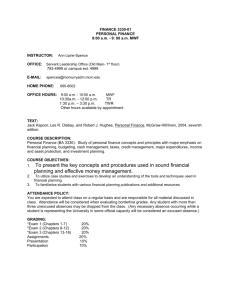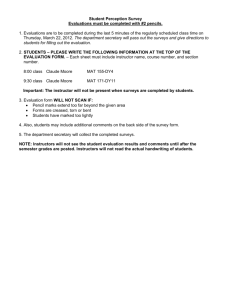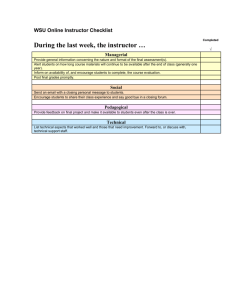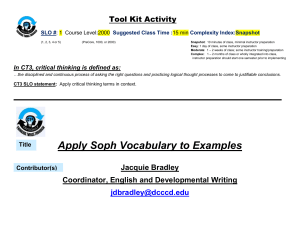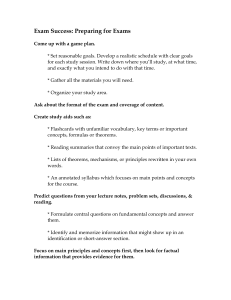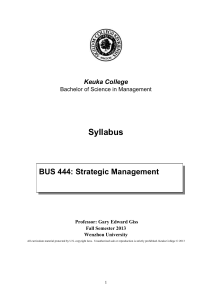Updated 09/02/08
advertisement
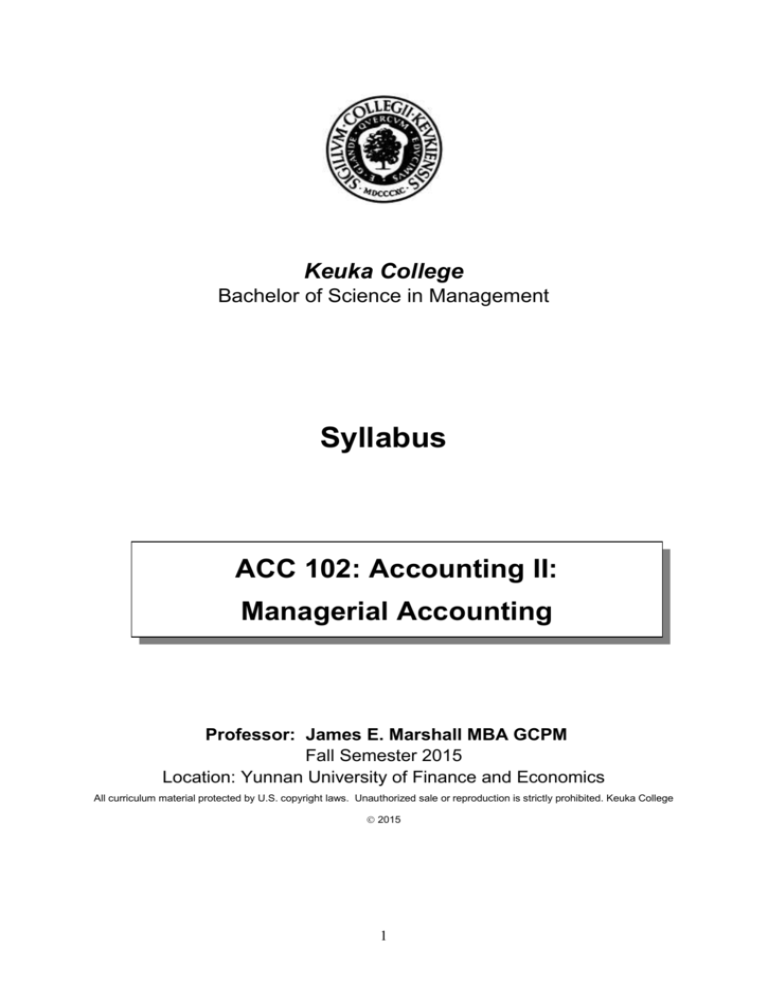
Keuka College Bachelor of Science in Management Syllabus ACC 102: Accounting II: Managerial Accounting Professor: James E. Marshall MBA GCPM Fall Semester 2015 Location: Yunnan University of Finance and Economics All curriculum material protected by U.S. copyright laws. Unauthorized sale or reproduction is strictly prohibited. Keuka College 2015 1 Keuka College ACC 102 Accounting II: Managerial Accounting Professor: James Marshall MBA, GCPM Location: YUFE Telephone: E-Mail : profmarshallyufe@yahoo.com Instructor Bio: Welcome to another leg of your future and another step toward your career. It is an honor and a privilege to have you all as students here at Keuka College and Yunnan University of Finance and Economics, and a great opportunity for me as your facilitator for this term. My teaching philosophy is very cut and dry; you get out of life what you put in it. You will constantly here me say “This is vital and you have to commit. My class thrives on individuals bringing insight to the class that fuels other individuals to participate while I hold the match that starts the fire of learning. I have about 25years of schooling and I am constantly seeking more knowledge. I acquired my Bachelors in Mechanical Engineering from the Newport News Apprentice School, and then received a Certificate of Business Management from Thomas Nelson University and later an Electronic Engineering degree from ITT Tech. After moving to Atlanta Georgia, I attended Devry University where I received my undergraduate degree in Project Management and continued on to Keller Graduate School of Management where I received my MBA and Graduate Certificate of Project Management. I am the CEO of ATG Consulting and Project Management also a consultant for Gerson Lehrman Group. I bring a lot of real world experience to the class room and as a professional student I believe this is the best way to educate. To get an excellent education you have to commit because this is vital, see you in class . Instructor Availability: You will be able to speak with the instructor before and following each class session. Appointments for additional meeting times may be made following each class session. Course Credits: 3 credits COURSE DESCRIPTION: Students will understand the importance of accounting practices related to planning, controlling, and decision making in the organization. This Managerial Accounting course will 2 help identify what kinds of information are needed, where it can be obtained, and how managers can apply this information. Content includes budgeting, job costing, product pricing, breakeven analysis, standard costing, and decision models. TEXT BOOK: Introduction to Management Accounting, Charles T. Horngren, Gary L. Sundem, William O. Stratton, Peking University Press, 15th Edition, 2013, 978-7-301-217818 COURSE RESOURCES: Introduction to the library for international students: http://libguides.keuka.edu/international http://libguides.keuka.edu/cat.php?cid=35791 STUDENT LEARNING OUTCOMES (SLOs) By the end of the course students will 1. Define and describe financial reporting using basic accounting principles and concepts 2. Describe methods, procedures and processes required to keep reliable, accurate and ethical financial records. 3. Define and describe the terms and processes of internal cost and external financial accounting, including financial statement components How assessed? Exams and inclass activities In-class activities and quizzes, exams Class activities and projects 4. Practice and apply, through problems and variable solutions, the tools and processes commonly used in accounting. Class activities and exams 5. Analyze and describe the role of accounting in management decision-making. Class activities and exams COURSE REQUIREMENTS The following are the requirements for this course: In-class Activities Each day, there will be a written assignment given in class; sometimes, these assignments will be team-based, other times, they will be individual assignments. There may be unannounced “pop” quizzes. If you are not in class, you will receive a zero for both the daily assignment and class participation for that day. Make-up work is not permitted. 3 Exams, of which one will be the final exam. More information on exam formats will be provided in class. WEIGHTING OF ASSIGNMENTS POINT VALUE Class Participation 10 In-class Assignments and quizzes 50 Exams (2) 40 Total 100 *See Appendix B for rubrics indicating how assignments will be graded OUTLINE OF THE COURSE All schedules in this syllabus are tentative and subject to change. Bloom’s Taxonomy Levels: 1- Knowledge 2- Comprehension 3- Analysis 4- Application 5- Synthesis 6Evaluation WEEK 1 WEEK 1 Topic In-Class Activity Assignments Introductions & Class Policies Chapter 1 Introductions Read Chapters 1-3 Chapter 2 & 3 Chapter Lectures & Discussions Chapter 4 & 5 Quiz Chapters 1 - 3 Read Chapters 4-6 Chapter 6 & 7 Chapter Lectures & Discussions PPT Presentation #1 TBA Chapter 8 & 9 Quiz Chapters 4 - 6 Read Chapters 7-11 Chapter 10 & 11 Midterm Exam Chapters 1 - 10 SLO(s) covered: Chapter Lectures & Discussions Bloom’s level(s): WEEK 2 SLO(s) covered: Bloom’s level(s): WEEK 3 SLO(s) covered: Bloom’s level(s): WEEK 4 SLO(s) covered: Bloom’s level(s): WEEK 5 SLO(s) covered: Bloom’s level(s): WEEK 6 SLO(s) covered: 4 Bloom’s level(s): WEEK 7 Chapter 12 & 13 Quiz Chapter 11 Read Chapter 12-14 PPT Presentation #2 TBA Chapter 14 & 15 Chapter Lectures & Discussions Read Chapters 15-17 PPT Presentation #3 TBA Chapter 16 Chapter Lectures & Discussions SLO(s) covered: Bloom’s level(s): WEEK 8 SLO(s) covered: Bloom’s level(s): WEEK 9 SLO(s) covered: Bloom’s level(s): Chapter 16 & 17 WEEK 10 PPT Presentation #4 TBA SLO(s) covered: Bloom’s level(s): 4, 5, 6 FINAL EXAM WEEK 11 SLO(s) covered: Bloom’s level(s): WEEK 12 SLO(s) covered: Exam feedback Student evaluations 12 Bloom’s level(s): Grading Guidelines for Transfer Credit (International Programs) The chart below depicts how course points will equate to grades. QUALITY POINTS POINTS 4.00 93-100 A- 3.67 90 - 92 B+ 3.33 87 - 89 3.00 83 - 86 B- 2.67 80 - 82 C+ 2.33 77 - 79 2.00 73 - 76 C- 1.67 70 - 72 D+ 1.33 67 - 69 1.00 63 - 66 0.67 60 - 62 0 0-59 A B C D SUPERIOR COMMENDABLE SATISFACTORY DEFICIENT DF FAILING Outstanding work not completed in 30 days will result in a grade of “F.” 5 Expectations English Language Skills This course and the Business Management degree program are focused on increasing English proficiency as well as business management skills. Students need to demonstrate strong English language skills to succeed in this course, it is suggested that students read any assigned readings carefully prior to class discussions. Here is one method: 1. First, print out the readings so there is a copy of the reading to work with. 2. Then, using a dictionary, look up and write out (on the copy) the Chinese definitions of key words in the assignment. 3. Work through the assignment before class, so there is a general understanding of what the reading is about. 4. Ask the instructor about phrases or statements in the assignment that still are difficult to understand. 5. Write down what the instructor says about the reading assignment on the sides, bottom, or on the back of the copy of the reading assignment. This will provide a good study guide for any exam on this material. IT IS THE STUDENT’S JOB TO ASK QUESTIONS! The instructor cannot guess what a student does not understand. The instructor expects and appreciates students’ questions. Students who ask the most questions in class often get the highest grades. COURSE ATTENDANCE and PROFESSIONAL BEHAVIOR Attendance is mandatory. Being on time and prepared to do your job is a key business behavior. This is a business course and so it requires a business-like approach to attendance, fulfilling assignments, meeting deadlines, conducting respectful and professional conversations, and handing in homework. Attendance Students need to be in their seats ready to answer the roll call by the beginning of class. Each class in a business program is like a business meeting. Attendance will be taken during each session. 6 Students who miss 4 hours of instruction in a course may have their grade lowered by one letter grade. For example, an A grade will be lowered to a B. Students who miss an additional 4 hours of instruction may have their grade lowered another full grade. For example, a B grade will be lowered to a C. Students who miss 12 or more hours of instruction will fail the course. Homework and Written Assignments When homework is given, it is due at the beginning of class when the instructor calls for it to be turned in. Late homework is not accepted for any reason and a grade of zero will be entered. Daily written assignments are due at the end of class when the instructor calls for it to be turned in. Late written assignments are not accepted for any reason and a grade of zero will be entered. Extra credit or make-up work is not permitted in this course. Homework and written assignments are to be completed in your own words. See section on “Academic Honesty” below. Class Participation The instructor expects students to focus on in-class exercises and lectures and make an effort to understand the point of the lecture or exercise. If the instructor finds students sleeping in class, chatting loudly with classmates, reading books from other classes, or spending class time to do something other than participating actively in what is planned for the class that day, the instructor may deduct points from the student’s final grade and/or expel the student from the class. Academic Honesty Academic honesty is very important to Keuka College. All written work must meet the standards of work for students at Keuka College, set by the faculty. Plagiarism (the use of another’s material without citation or reference) will not be tolerated. Cheating on exams or copying parts of other’s assignments will result in a ‘0’ grade for that assignment for all parties involved. That means both the person who copies from another student and the person who allows their work to be copied may receive a ‘0’ grade. 7 Cheating on a final exam or final project can result in a student receiving an “F” for the course. The instructor may also officially notify the university that students were caught cheating and identify the names of the cheaters. Examples of cheating are: Having a tutor or friend complete all or a portion of an assignment Having any other person make revisions to a student’s final work Copying work submitted by another student Using information from online information services without proper citation Completing a test with answers other than the student’s own Using a cell phone to receive text answers during an exam Using a cell phone to text a friend about the questions on an exam Writing information on a desk to use in an exam Using an electronic translator to store information for an exam Bringing notes of any sort into an exam unless authorized by the instructor Attempting to buy an exam Other efforts to use other people’s work instead of one’s own work 8 Appendix A: College Vision, Mission & Program Outcomes KEUKA COLLEGE VISION STATEMENT To be renowned as a global leader in comprehensively integrating liberal arts, digital technologies, experiential learning, and professional practice. KEUKA COLLEGE MISSION STATEMENT To create exemplary citizens and leaders to serve the nation and the world of the 21st century. We provide a transformational liberal arts-based education, strengthened by experiential learning that challenges students to develop their intellectual curiosity and to realize, with purpose and integrity, their full personal and professional potential. STATEMENT OF PROGRAM OUTCOMES On successful completion of the Keuka College B.S.M. degree a student will be able to demonstrate mastery of the following Program Outcomes: 1. Functional Components of a Business: Identify and define the functional components of a business (management, accounting, marketing, finance, human resources, and economics) and their interrelationships. 2. Critical Thinking: Demonstrate the ability to apply critical thinking and decision-making skills across the functional components of a business. 3. Written & Verbal Communication: Demonstrate the ability to express themselves clearly, concisely, and logically through effective oral and written communication. 4. Information Technology: Demonstrate the ability to utilize current technology to maximize managerial effectiveness in the achievement of tactical and strategic objectives. 5. Applied Business Skills: Demonstrate applied business skills in their chosen areas of concentration. This course, ACC 102 Introduction to Management Accounting, addresses Program Outcomes numbered 1, 2, 3, 4 and 5 above. 9 Appendix B: Course Project All schedules in this syllabus are tentative and subject to change. ACC 102 Managerial Accounting COURSE PROJECT I Class Team Projects 1. Each of the classes will form teams that represent complete companies. They will develop and incorporate a Value Chain for the manufacture of products that they will sell to another class. Another team will resell these goods to raise money for charity or other managerial options. 2. The learning objectives for these projects are for students to experience all aspects of the Value Chain, from purchasing through manufacturing, and support functions such as finance, marketing, sales, and customer support. 3. Students will be evaluated by the Professor on the quality of their planning and organization, and on the effectiveness of their operations. There also will be an element of evaluation from the “customers” in the second team that is purchasing goods from the Operations Management teams. 4. Each Operations Management class will receive a “loan” for use in purchasing raw materials for production of products for sale. At the end of the project, each class should have recovered the full value of the loan, and will repay the loan. Any excess funds (profits) will be donated to one or more of the charities supported by the “customer” class. Any team that has a shortfall of funds will have to give a power point presentation identifying possible areas that caused the shortfall. ACC 102 Managerial Accounting COURSE PROJECT II Each member of the group will prepare a 5-page double-spaced paper. That is, if your group is 3 people, then your group needs to turn in at least a 15-page paper. You will present your paper in the class using PowerPoint slides, at least 3 slides per member. You have a choice of the following topics. 1. Discuss and compare the advantages and disadvantages of Target Costing, provide examples and implementation. How would you apply this method in a Chinese company; give detailed example. 2. Discuss the advantages and disadvantages of Activity Based Costing, how to implement the system. How would you apply this method in a Chinese company; give detailed example. 3. Discuss Performance Measures, such as balanced scored cards, what are the methods, and how to implement the measures. How would you apply this method in a Chinese company; give detailed example. 10 4. Discuss Economic Value Added (EVA), how to implement it and provide examples. How would you apply this method in a Chinese company; give detailed example. 5. Conversion of regular inventory management system to a computerized ERP in a Chinese company. How would you apply this method in a Chinese company; give detailed example. 6. Discuss Value Chain and its importance in a business environment, demonstrate and measure the value chain in a Chinese company. How would you apply this method in a Chinese company; give detailed example. GRADING RUBRIC Individual Assignment Grading Criteria POSSIBLE POINTS Content Quality Student clearly defines the specific issue and current problems or conflicts created by the issue, including the historical development. Student accomplished the objectives of the assignment. Student discusses significance of the issue to the topic under study. Adequate support is provided for assertions. Relevant perspectives and positions are analyzed. 1 1 1 Effective Expression of Ideas Student selected an appropriate writing strategy and style. Organization emphasizes the central theme or purpose. Each paragraph contains only one main idea, logically developed. Information is properly sequenced throughout the paper. Appropriate headings are included. 1 Smoothness of Expression Sequencing of topics is logical. Paper evidences coherence through use of appropriate transitions. Definitions are provided as needed. Sentences are well built with strong, but varied structure. Sentences are fluid. No shifts in tense or voice are evident. Economy of Expression Student used words and sentences appropriately. Writing is full and rich, yet concise. Paper is not excessively wordy or full of redundancies. Student used powerful verbs, active voice, and appropriate vocabulary. 1 1 1 Precision and Clarity Word choices convey the message in an interesting, precise, and 1 natural way. Student avoids colloquial expressions and jargon. Proper spelling, grammar and punctuation are used. Presentation Quality Paper is professional in appearance with appropriate font choice and size. Paper has been carefully edited. Paper conforms to APA standards for format and citation of sources. References are current and thorough. 2 TOTAL 10 11 POINTS EARNED

